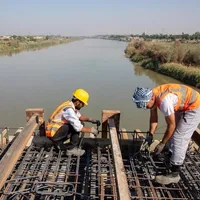Footage published from Abdanan, in Ilam province, showed torrents of water sweeping through residential districts and damaging roads and neighborhoods.
Local officials said downpours in Abdanan and Dehloran led to overflowing waterways, the swelling of several rivers and the emergency evacuation of a number of families.
Relief teams from the Iranian Red Crescent were deployed to pump water out of flooded homes and clear blocked streets, authorities said.
Damage assessments were continuing on Monday, with officials saying their immediate priority was helping families whose houses had been inundated.
The national meteorological organization issued flood warnings for six western provinces and forecast rainfall in 18 of the country’s 31 provinces.
It said precipitation across Iran this year is roughly 85% below average, a shortfall that has emptied reservoirs and left taps running dry in several regions, including parts of Tehran.
Experts and officials have attributed the worsening crisis to prolonged drought, climate change, poor water management, illegal well drilling and inefficient agricultural practices.
Extended dry spells reduce the soil’s ability to absorb water, increasing the likelihood of flash floods when rain does occur.
Over the weekend, Iran conducted its first cloud-seeding operation of the year above the watershed of Lake Urmia in the northwest.
Cloud seeding involves dispersing chemicals into clouds to stimulate rainfall, though meteorologists caution that it is expensive and provides only limited benefit.
“In addition to cloud seeding’s heavy cost, the amount of rainfall it produces is nowhere near what is needed to solve our water crisis,” Sahar Tajbakhsh, head of Iran’s Meteorological Organization, told state television on Sunday.










